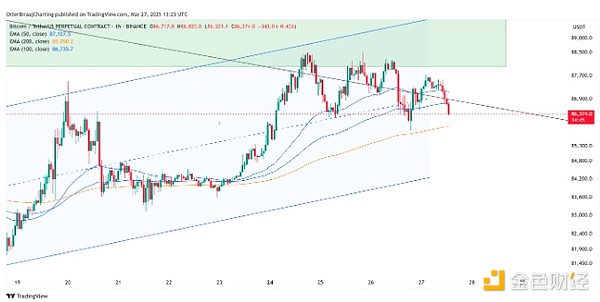
Author: Biraajmaan Tamuly, CoinTelegraph; Compiled by: White Water, Golden Finance
Since its weekly high of $88,752 on March 24, the price of Bitcoin has formed a series of lower highs and lower lows in the 1-hour time frame chart.
As the weekend approached, Bitcoin price failed to break through the $88,000 resistance, reducing the chance of retesting $90,000 before the end of the first quarter.
Bitcoin 1 hour chart. Source: Cointelegraph/TradingView
What makes Bitcoin price below $90,000?One of the main reasons for Bitcoin’s current price struggles is the constant seller pressure from short-term holders (STHs) or investors who have held Bitcoin for less than 155 days. Glassnode points out that the current Bitcoin cycle has witnessed a “top-heavy” market where investors who buy BTC at higher prices hold a large portion of the Bitcoin supply. Therefore, the STH group has become the main group facing the biggest price drop since Bitcoin pulled back 30% from its all-time high.
In the report, Glassnode analysts said
"Short-term holders lost supply surged to 3.4 million BTC. This is the largest amount of STH supply loss since July 2018."
The total supply loss of Bitcoin held by STH. Source: Glassnode
Selling pressure faced by short-term holders is reflected in Bitcoin’s cumulative trend score.
Bitcoin’s cumulative trend score, an indicator of quantitative selling pressure, has been below 0.1 since the BTC price dropped from $108,000 to the $93,000-$97,000 range. Scores below 0.5 indicate distribution (sell) rather than accumulation, while values below 0.1 highlight strong selling pressure.
Another reason why Bitcoin is difficult to break through the $90,000 threshold is the contraction of liquidity conditions. Data shows that on-chain transfers have dropped to $5.2 billion per day, a 47% drop from the peak during the rebound to an all-time high. Similarly, the number of active addresses has also decreased by 18%, from 950,000 in November 2024 to 780,000.
At the same time, open contracts (OI) in the BTC futures market fell from $71.85 billion to $54.65 billion, a 24% decline, perpetualThe interest rate for financing also fell.
This deleveraging and liquidity contraction, coupled with profits from only 2.5% of the total supply during the adjustment period, limits the market's ability to rebound to more than $90,000, as buying orders are not enough to absorb sell orders.
New demand for Bitcoin continues to declineThe current BTC bull cycle lacks new demand (buyers) entering the market, and the cost base distribution (CBD) heat map shows that supply is concentrated at higher price levels ($100,000 to $108,000), but there is no influx of buyers at lower levels to drive price recovery.
Bitcoin fanatic zone, the cost base for top buyers. Source: Glassnode
The factors of insufficient demand are exacerbated by macroeconomic uncertainty, which hinders new investors' participation, as seen when the 1-week to 1-month STH cost base falls below the 1-month to 3-month cost base.
However, Glassnode analysts said, “The other side of these observations is that the long-term holder community still retains a considerable portion of the online wealth, holding nearly 40% of the investment value.”
Essentially, these periods of long-term accumulation will ultimately limit supply, creating better conditions for a new wave of demand once the market forms a stronger upward trend.












